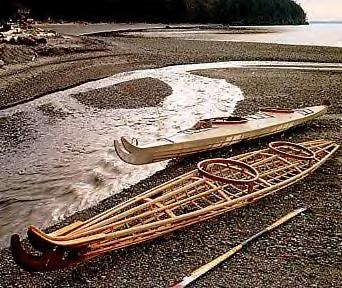|
|
Canku Ota |
|
|
(Many Paths) |
||
|
An Online Newsletter Celebrating Native America |
||
|
March 24, 2001 - Issue 32 |
||
|
|
||
|
Whalers Rely on Skill of Sage |
||
|
by Tim Macdonald Arctic Sounder |
||
 Barrow --
When whalers take to the ice in May, they hunt the huge marine mammals from age-old boats made from rawhide seal
hides, sewn together and stretched over a fragile wooden frame. Barrow --
When whalers take to the ice in May, they hunt the huge marine mammals from age-old boats made from rawhide seal
hides, sewn together and stretched over a fragile wooden frame. With nothing but a piece of leather between them and the lethal waters of the Arctic Ocean, the men hunting the whales are very particular about the seams in the skins. That is why Priscilla Sage works on most of the boats made in Barrow. March is the time of the Amiq, the covering of the skin boats. The process really began the previous summer, with the harvesting of the five to seven oogrook, or bearded seals, whose hides will make up the covering of the skin boat. The seals are skinned, and blocks of fat are folded into the hides. The hides are kept where they won't freeze, to cure until just before the Amiq. Men from the whaling crew then scrape the hair from the hides and soften them for sewing. The duties of the Amiq are divided by gender. Women traditionally sew, and men cover the boat with the skins. As many as a dozen women sit around the skins, wearing ponchos fashioned from garbage bags to protect their clothing from the pungent seal oil. Sage is usually in charge of training and quality control. "She's the expert," Margaret Opie said at Johnny Leavitt's Amiq. "I think I'm more like a troubleshooter," Sage said. "I just know what to do if something needs fixing." Sage also shows the novice seamstresses how to sew the seams with the traditional thread made from caribou sinew. She knows the thread made from the hamstrings is stronger than that made from the shoulders, and she knows how to keep the seams straight and tight. "This is my second skin boat," Colleen Akpik said. "The first time, Priscilla took out all my stitches and made me sew them again." Sage has been stitching boats for 30 years. "I started in '71, when I sewed my first skin boat. My mom taught me," Sage said. "But I was not always sewing when I first started. I would have to work and so on, before I learned the importance of it. It changed my mind. I knew it was different when some of the older ladies who knew how to do these things were dying one by one," Sage said. "My mother helped convince me that I must learn so I can pass this on, so these things don't die out." The skins are joined with a seam, and then the work is turned over and the seams are doubled, like the double seam in a pair of work jeans. Seal oil is worked into the seams for waterproofing. Sage has come to believe that there is a spiritual force that helps her with the skin boats. "Sometimes I do things that I have never done before, that nobody taught me," she said. "I didn't really believe in it before, but I think maybe it is my namesakes, the spirits of those that came before me, that show me the way to do some things. "I mean, I just know how to do some things that I haven't been taught, and I believe maybe those that came before me are helping," Sage said. |
|
Skin Boats |
|
|
||
|
|
||
| Canku Ota is a free Newsletter celebrating Native America, its traditions and accomplishments . We do not provide subscriber or visitor names to anyone. Some articles presented in Canku Ota may contain copyright material. We have received appropriate permissions for republishing any articles. Material appearing here is distributed without profit or monetary gain to those who have expressed an interest. This is in accordance with Title 17 U.S.C. section 107. | ||
|
Canku Ota is a copyright © 2000, 2001 of Vicki Lockard and Paul Barry. |
||
|
|
The "Canku Ota - A Newsletter Celebrating Native America" web site and its design is the |
|
|
Copyright © 1999, 2000, 2001 of Paul C. Barry. |
||
|
All Rights Reserved. |
